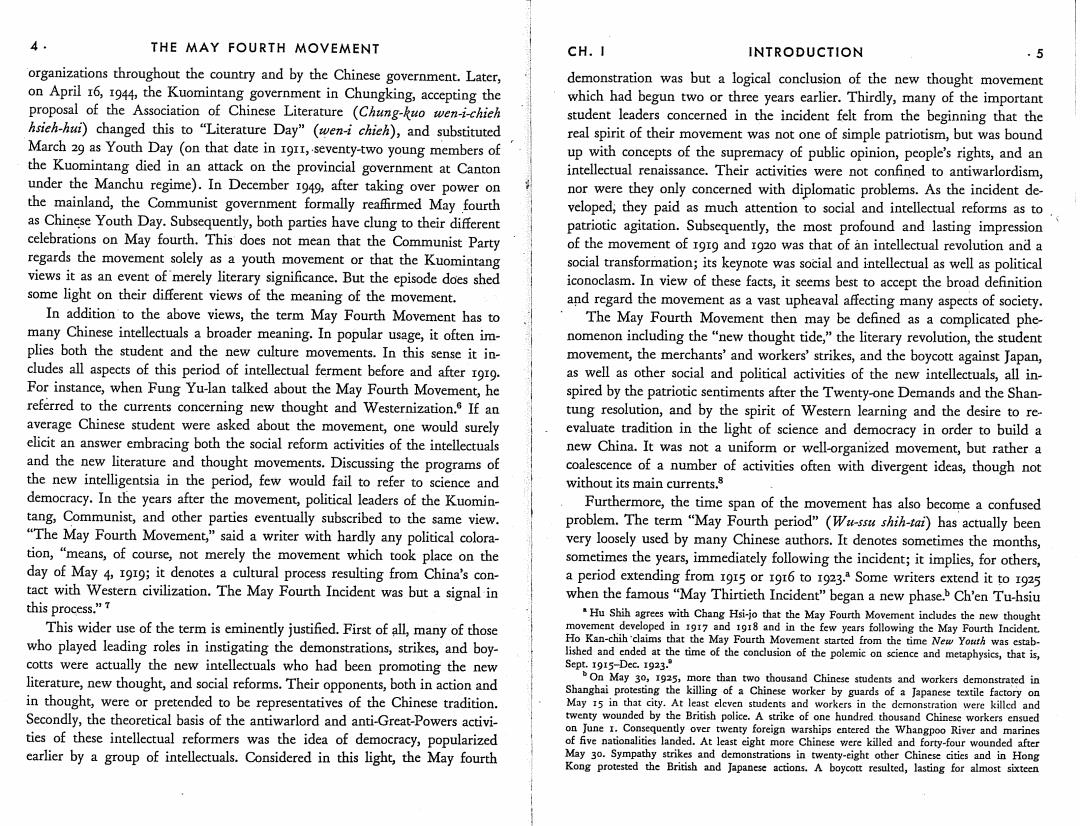正在加载图片...

4… THE MAY FOURTH MOVEMENT CH.I INTRODUCTION …5 organizations throughout the country and by the Chinese government.Later, demonstration was but a logical conclusion of the new thought movement on April 16,1944,the Kuomintang government in Chungking,accepting the which had begun two or three years earlier.Thirdly,many of the important proposal of the Association of Chinese Literature (Chung-kuo wen-i-chieh student leaders concerned in the incident felt from the beginning that the hsich-hui)changed this to "Literature Day"(wen-i chieh),and substituted real spirit of their movement was not one of simple patriotism,but was bound March 29 as Youth Day (on that date in IoII,seventy-two young members of up with concepts of the supremacy of public opinion,people's rights,and an the Kuomintang died in an attack on the provincial government at Canton intellectual renaissance.Their activities were not confined to antiwarlordism, under the Manchu regime).In December 1949,after taking over power on nor were they only concerned with diplomatic problems.As the incident de- the mainland,the Communist government formally reaffirmed May fourth veloped,they paid as much attention to social and intellectual reforms as to as Chinese Youth Day.Subsequently,both parties have clung to their different patriotic agitation.Subsequently,the most profound and lasting impression celebrations on May fourth.This does not mean that the Communist Party of the movement of rorg and rg2o was that of an intellectual revolution and a regards the movement solely as a youth movement or that the Kuomintang social transformation;its keynote was social and intellectual as well as political views it as an event of merely literary significance.But the episode does shed iconoclasm.In view of these facts,it seems best to accept the broad definition some light on their different views of the meaning of the movement. and regard the movement as a vast upheaval affecting many aspects of society. In addition to the above views,the term May Fourth Movement has to The May Fourth Movement then may be defined as a complicated phe- many Chinese intellectuals a broader meaning.In popular usage,it often im- nomenon including the "new thought tide,"the literary revolution,the student plies both the student and the new culture movements.In this sense it in- movement,the merchants'and workers'strikes,and the boycott against Japan, cludes all aspects of this period of intellectual ferment before and after Iorg. as well as other social and political activities of the new intellectuals,all in- For instance,when Fung Yu-lan talked about the May Fourth Movement,he spired by the patriotic sentiments after the Twenty-one Demands and the Shan- referred to the currents concerning new thought and Westernization.If an tung resolution,and by the spirit of Western learning and the desire to re. average Chinese student were asked about the movement,one would surely evaluate tradition in the light of science and democracy in order to build a elicit an answer embracing both the social reform activities of the intellectuals new China.It was not a uniform or well-organized movement,but rather a and the new literature and thought movements.Discussing the programs of coalescence of a number of activities often with divergent ideas,though not the new intelligentsia in the period,few would fail to refer to science and without its main currents.3 democracy.In the years after the movement,political leaders of the Kuomin- Furthermore,the time span of the movement has also become a confused tang,Communist,and other parties eventually subscribed to the same view. problem.The term "May Fourth period"(Wa-sst shih-tai)has actually been "The May Fourth Movement,"said a writer with hardly any political colora- very loosely used by many Chinese authors.It denotes sometimes the months, tion,"means,of course,not merely the movement which took place on the sometimes the years,immediately following the incident;it implies,for others, day of May 4;it denotes a cultural process resulting from China's con- a period extending from I9I5 or 19r6 to 1g23.Some writers extend it to 1925 tact with Western civilization.The May Fourth Incident was but a signal in this process,”7 when the famous"May Thirticth Incident"began a new phase.Ch'en Tu-hsiu Hu Shih agrees with Chang Hsi-jo that the May Fourth Movement indudes the new thought This wider use of the term is eminently justified.First of all,many of those movement developed in 1917 and 1918 and in the few years following the May Fourth Incident. who played leading roles in instigating the demonstrations,strikes,and boy- Ho Kan-chih'claims that the May Fourth Movement started from the time New Youth was estab- lished and ended at the time of the conclusion of the polemic on science and metaphysics,that is, cotts were actually the new intellectuals who had been promoting the new Sep.19r5-Dcc.1923.” literature,new thought,and social reforms.Their opponents,both in action and On May 30,1925,more than two thousand Chinese students and workers demonstrated in in thought,were or pretended to be representatives of the Chinese tradition. Shanghai protesting the killing of a Chinese worker by guards of a Japanese textile factory on May 15 in that city.At least cleven students and workers in the demonstration were killed and Secondly,the theoretical basis of the antiwarlord and anti-Great-Powers activi- twenty wounded by the British police.A strike of one hundred.thousand Chinese workers ensued ties of these intellectual reformers was the idea of democracy,popularized on June 1.Consequently over twenty foreign warships entered the Whangpoo River and marines of five nationalities landed.At least eight more Chinese were killed and forty-four wounded after earlier by a group of intellectuals.Considered in this light,the May fourth May 30.Sympathy strikes and demonstrations in twenty-eight other Chinese cities and in Hong Kong protested the British and Japanese actions.A boycott resulted,lasting for almost sixteen